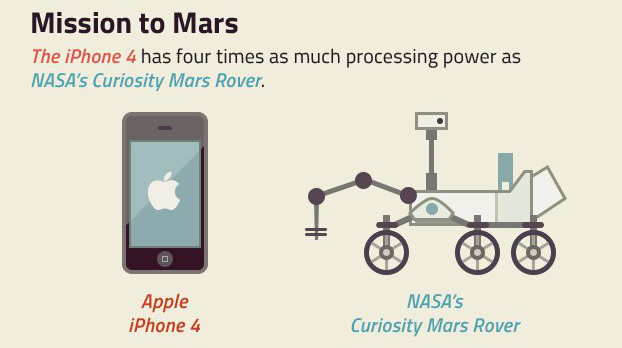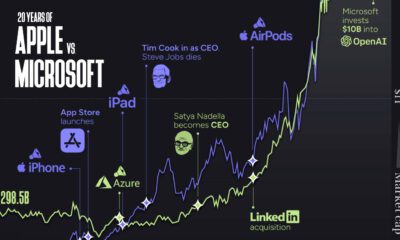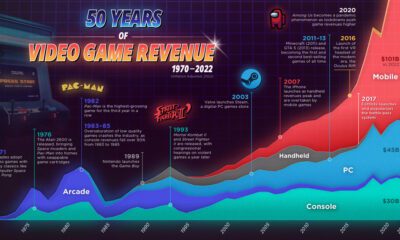Technology
The Supercomputer In Your Pocket

The Supercomputer in Your Pocket
We have mentioned here many times that the exponential rise in technology creates unprecedented opportunities for investors. Smaller and faster computers have led to emerging fields such as big data, the internet of things, cybersecurity, and the mobile payments revolution.
It all stems from Moore’s Law, which is based on observations made as early as 1965 by Gordon E. Moore, the co-founder of Intel. Moore suggested that the number of transistors in a dense integrated circuit would double approximately every two years, creating an exponential rise in computing potential.
However, for many this whole “exponential” thing is hard to wrap our heads around. Most of our daily observations are on a linear level, meaning that relationships hold true at a fixed rate. For example, if one wishes to bake a chocolate cake that is twice the size as a given recipe, the ingredients are to be doubled. If one is buying three cartons of milk from the grocery store, the cost will be three times higher.
Exponential Growth
Here’s an example of an exponential situation that just doesn’t feel intuitive. For the full version, which is worth reading, go to Peak Prosperity as they explain the compounding problem. Otherwise I will paraphrase:
Imagine that you are in Fenway Park, that the stadium is watertight, and you are handcuffed to the very highest bleacher seats. Meanwhile a drop of water is dropped on the pitcher’s mound, and the amount of water dropping will double every minute. How long do you have to escape from the handcuffs before drowning? Minutes, hours, days, years?
The answer turns out to be 49 minutes. Even more interesting is that most people wouldn’t be aware of how dire the situation until about 45 minutes, when the stadium is about 7% full of water and about to double yet again.
This example illustrates exponential growth. Applied to technology, it means that even though we have seen big advances over the last few decades with the emergence of personal computers, smartphones, and even smaller connected devices, the best is still yet to come.
Quantum computing and general artificial intelligence are approaching us faster than we may know.
Original graphic by: Fonebank
Technology
Visualizing AI Patents by Country
See which countries have been granted the most AI patents each year, from 2012 to 2022.

Visualizing AI Patents by Country
This was originally posted on our Voronoi app. Download the app for free on iOS or Android and discover incredible data-driven charts from a variety of trusted sources.
This infographic shows the number of AI-related patents granted each year from 2010 to 2022 (latest data available). These figures come from the Center for Security and Emerging Technology (CSET), accessed via Stanford University’s 2024 AI Index Report.
From this data, we can see that China first overtook the U.S. in 2013. Since then, the country has seen enormous growth in the number of AI patents granted each year.
| Year | China | EU and UK | U.S. | RoW | Global Total |
|---|---|---|---|---|---|
| 2010 | 307 | 137 | 984 | 571 | 1,999 |
| 2011 | 516 | 129 | 980 | 581 | 2,206 |
| 2012 | 926 | 112 | 950 | 660 | 2,648 |
| 2013 | 1,035 | 91 | 970 | 627 | 2,723 |
| 2014 | 1,278 | 97 | 1,078 | 667 | 3,120 |
| 2015 | 1,721 | 110 | 1,135 | 539 | 3,505 |
| 2016 | 1,621 | 128 | 1,298 | 714 | 3,761 |
| 2017 | 2,428 | 144 | 1,489 | 1,075 | 5,136 |
| 2018 | 4,741 | 155 | 1,674 | 1,574 | 8,144 |
| 2019 | 9,530 | 322 | 3,211 | 2,720 | 15,783 |
| 2020 | 13,071 | 406 | 5,441 | 4,455 | 23,373 |
| 2021 | 21,907 | 623 | 8,219 | 7,519 | 38,268 |
| 2022 | 35,315 | 1,173 | 12,077 | 13,699 | 62,264 |
In 2022, China was granted more patents than every other country combined.
While this suggests that the country is very active in researching the field of artificial intelligence, it doesn’t necessarily mean that China is the farthest in terms of capability.
Key Facts About AI Patents
According to CSET, AI patents relate to mathematical relationships and algorithms, which are considered abstract ideas under patent law. They can also have different meaning, depending on where they are filed.
In the U.S., AI patenting is concentrated amongst large companies including IBM, Microsoft, and Google. On the other hand, AI patenting in China is more distributed across government organizations, universities, and tech firms (e.g. Tencent).
In terms of focus area, China’s patents are typically related to computer vision, a field of AI that enables computers and systems to interpret visual data and inputs. Meanwhile America’s efforts are more evenly distributed across research fields.
Learn More About AI From Visual Capitalist
If you want to see more data visualizations on artificial intelligence, check out this graphic that shows which job departments will be impacted by AI the most.
-

 Markets1 week ago
Markets1 week agoU.S. Debt Interest Payments Reach $1 Trillion
-

 Markets2 weeks ago
Markets2 weeks agoRanked: The Most Valuable Housing Markets in America
-

 Money2 weeks ago
Money2 weeks agoWhich States Have the Highest Minimum Wage in America?
-

 AI2 weeks ago
AI2 weeks agoRanked: Semiconductor Companies by Industry Revenue Share
-

 Markets2 weeks ago
Markets2 weeks agoRanked: The World’s Top Flight Routes, by Revenue
-

 Countries2 weeks ago
Countries2 weeks agoPopulation Projections: The World’s 6 Largest Countries in 2075
-

 Markets2 weeks ago
Markets2 weeks agoThe Top 10 States by Real GDP Growth in 2023
-

 Money2 weeks ago
Money2 weeks agoThe Smallest Gender Wage Gaps in OECD Countries















